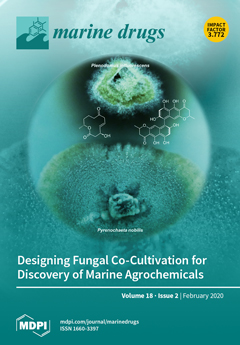Fucoidan is a brown algae-derived polysaccharide having several biomedical applications. This study simultaneously compares the anti-cancer activities of crude fucoidans from
Fucus vesiculosus and
Sargassum filipendula, and effects of low (LMW, 10–50 kDa), medium (MMW, 50–100 kDa) and high (HMW, >100 kDa)
[...] Read more.
Fucoidan is a brown algae-derived polysaccharide having several biomedical applications. This study simultaneously compares the anti-cancer activities of crude fucoidans from
Fucus vesiculosus and
Sargassum filipendula, and effects of low (LMW, 10–50 kDa), medium (MMW, 50–100 kDa) and high (HMW, >100 kDa) molecular weight fractions of
S. filipendula fucoidan against osteosarcoma cells. Glucose, fucose and acid levels were lower and sulphation was higher in
F. vesiculosus crude fucoidan compared to
S. filipendula crude fucoidan. MMW had the highest levels of sugars, acids and sulphation among molecular weight fractions. There was a dose-dependent drop in focal adhesion formation and proliferation of cells for all fucoidan-types, but
F. vesiculosus fucoidan and HMW had the strongest effects. G1-phase arrest was induced by
F. vesiculosus fucoidan, MMW and HMW, however
F. vesiculosus fucoidan treatment also caused accumulation in the sub-G1-phase. Mitochondrial damage occurred for all fucoidan-types, however
F. vesiculosus fucoidan led to mitochondrial fragmentation. Annexin V/PI, TUNEL and cytochrome c staining confirmed stress-induced apoptosis-like cell death for
F. vesiculosus fucoidan and features of stress-induced necrosis-like cell death for
S. filipendula fucoidans. There was also variation in penetrability of different fucoidans inside the cell. These differences in anti-cancer activity of fucoidans are applicable for osteosarcoma treatment.
Full article






